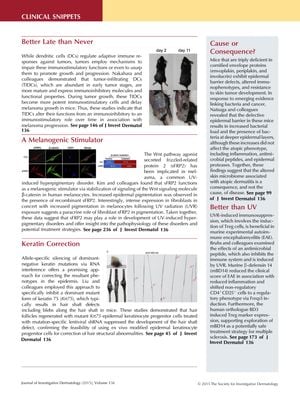Clinical Snippets: Research Findings in Dermatology
January 2016
in “
Experimental Dermatology
”

TLDR New findings suggest potential treatments for melanoma, hyperpigmentation, hair defects, and multiple sclerosis, and show skin microbiome changes don't cause atopic dermatitis.
The document presents several research findings in the field of dermatology. Nakahara and colleagues showed that tumor-infiltrating dendritic cells (TIDCs) in mice change from immunoinhibitory to immunostimulatory over time, potentially delaying melanoma growth. Kim and colleagues discovered that secreted frizzled-related protein 2 (sFRP2) acts as a melanogenic stimulator in human melanocytes, suggesting a role in UV-induced hyperpigmentary disorders like melasma. Liu and colleagues successfully used allele-specific RNA interference to suppress hair shaft defects caused by a dominant mutant form of keratin 75 (Krt75) in mice, indicating a potential treatment for hair structural abnormalities. Natsuga and colleagues found that mice deficient in certain cornified envelope proteins had an altered skin microbiome due to epidermal barrier defects, but this did not cause atopic dermatitis, suggesting the microbiome changes are a consequence of the disease. Lastly, Bruhs and colleagues reported that murine ß-defensin 14 (mBD14) reduced symptoms and inflammation in a mouse model of multiple sclerosis by inducing regulatory T cells, offering a potential new treatment strategy for the disease.




